18% Nickel Maraging Steels
06.08.2020
Varzene Metal

Maraging steel was developed in the 1950s to support the low density and temperature resistant (250 - 300 oC) material requirement in aviation. This new steel is the result of the addition of aluminum (Al) and titanium (Ti) to steel with Nickel. In the 1960s cobalt (Co) and molybdenum (Mo) were added to the maraging steel composition. These additions have been observed to be very effective in increasing mechanical resistance. Briefly, maraging steel is a steel that has been created by using displaced elements for aging hardening in the low carbon iron-nickel martensitic matrix.
Maraging got this name from the words "martensite" and "aging", which means aged martensitics. As a result of low carbon and alloying, aging heat treatment of maraging steel increases mechanical resistance and hardness. In the annealing process step, martensitic structure has high toughness and softness. This situation can then be modified by aging process. Due to the softness of the martensitic structure, it allows cold forming without intermediate heat treatment step. Cold rolling can be used as a mechanical process technique in maraging steel. The increase of the dislocation intensity during cold forming (rolling) increases the tensile strength and pour point. On the other hand, the aging process in which intermetallic sediments occur also improves the mechanical properties.
|
Table 1. Chemical composition and properties after 820 ° C annealing
|
|
Alloy
|
Composition
|
Properties
|
|
18Ni maraging steel (series)
|
Ni
|
Mo
|
Co
|
Ti
|
Al
|
Y.S.
|
Ultimate tensile strength
|
%E
|
RC
|
RA
|
|
200
|
18
|
3–3.5
|
8.5
|
0.2
|
0.1
|
~800
|
965–1000
|
17–18
|
28–30
|
72–80
|
|
250
|
18
|
~5
|
~7.75
|
0.4
|
0.1
|
750–900
|
1000–1140
|
8–16
|
28–35
|
55–70
|
|
300
|
18
|
~5
|
~9
|
0.6
|
0.1
|
760–900
|
1000–1170
|
6–15
|
30–32
|
45–60
|
|
350
|
18
|
4
|
12.5
|
1.6
|
0.1
|
|
|
|
|
|
The addition of Co and Mo to "iron - nickel martensite" has been observed to have a significant effect on aging hardening. The effect of the combination of the addition of Co and Mo revealed more excellent results than the results obtained by adding these elements separately. In addition, maraging steel family has been developed with the addition of titanium (Ti) and aluminum, which are very active in aging hardening, to the Fe-Ni-Co-Mo matrix.
Commercial classification of maraging steel was made as 18Ni (250) 18Ni (300) and 18Ni (350) depending on the nickel percentage.
Maraging steel is used in aviation, aircraft industry, nuclear and military industry; because of these properties such as good weldability, high strength, high yield strength, high fracture toughness, being suitable for use at high operating temperatures, good machinability and formability.
|
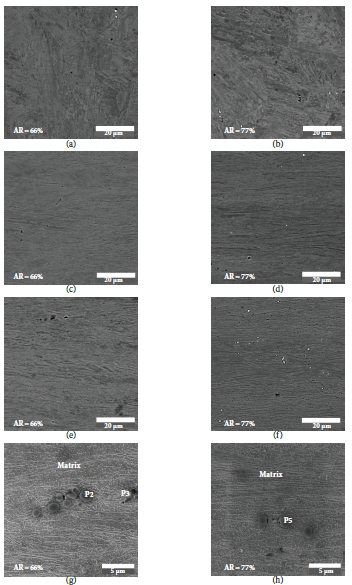
Figure 1. Microstructure of the maraging steel (a); (b) Annealed; (C); (d) Cold deformed; (to);
(f) 550 oC / 1h aged and (g); (h) 550 oC / 16h aged.
|
Table 2. Chemical composition of the phases formed (% wt.)
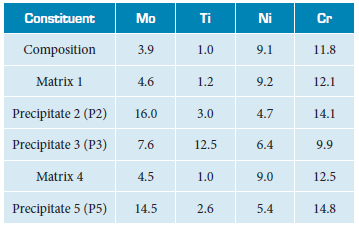
Table 3. Solution forms formed during aging of maraging steel
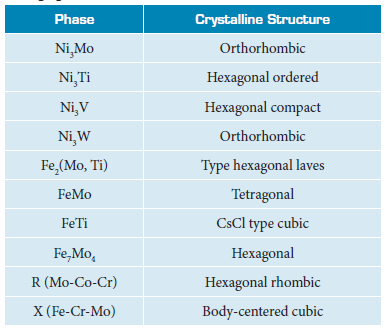
|
Table 4. Advantages of Nickel Maraging Steel
|
Perfect Machanical Properties
|
Production Process and Manufacturing Characteristic
|
Simple Heat Treatment
|
- High strength and strength / weight ratio
- High notch strength
- Continuation of high strength up to at least 350 oC
- High impact strength, resistance to plastic deformation
|
- It is suitable for many techniques such as hot and cold forming
- Excellent weldability in both annealed and aging conditions. No need for preheating
- Good Machinability
- Good castability
|
- There is no need for quenching. Softening and solubilization process takes place with air cooling at 820-900 oC.
- The hardening and strengthening process is achieved by aging at temperatures of 400-500 oC.
- It has no decarburization effect.
- Dimensional change is very low in aging process. This allows processing to finished sizes before hardening.
- Surface hardening can be done by nitration.
|
Melting and Production Methods
Nickel maraging steels are generally produced by vacuum melting method or double vacuum melting method.
What is targeted by these melting methods;
- Providing composition within the limit range determined in a closed controlled environment
- Minimizing segregation
- Obtaining clean microstructure with low gas content and high standards
Since non-metallic inclusions negatively affect fatigue strength, VAR (vacuum arc remelting), ESR (electro Slag Remelting) and EBM (electro Beam melting) processes are often used in maraging to create a homogeneous chemical structure.
Heat Treatment of Maraging Steel
Solution Annealing
The 18% Ni iron binary metallic alloy must be heated above 1150 oF to complete the gamma conversion. With the contribution of additional alloying elements, it is heated to a minimum of 1350 oF to complete the austenite conversion. In practice, the annealing temperature should be above the limit temperature. Precipitation is dissolved at 1500 oF and internal stresses are removed and adjustments are made for the next hot or cold process.
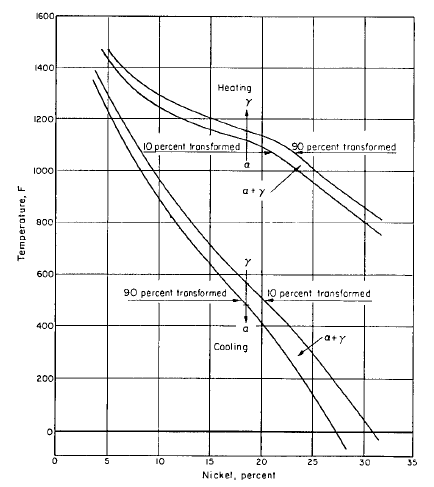
It is heated to 1650 oF and then reheated to 1525 oF or heated to 1750 oF and then reheated to 1400 oF by using this double annealing method and this process improves the strength and toughness values in the next heat treatment step.
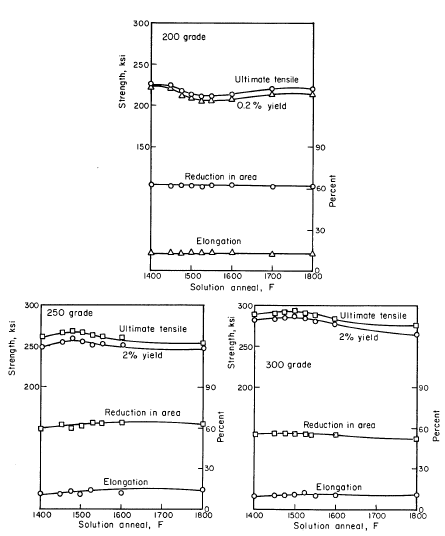
Figure 3. The effect of the solution annealing temperature on the tensile properties of 200-250 and 300 grade maraging steel after 900 oF and 3 hours aging.
Aging Heat Treatment
Hardness and strength increase when heated to temperatures below the austenite phase reinstatement temperature. For example, while the yield strength of 18 Ni maraging steel is 100000 Psi, it reaches 250000 psi with 3 hours aging at 900 oF temperature. The aging temperature range of maraging steel is between 750 oF and 950 oF. In industrial application, aging temperature is generally chosen as 900 oF and 3 hours.
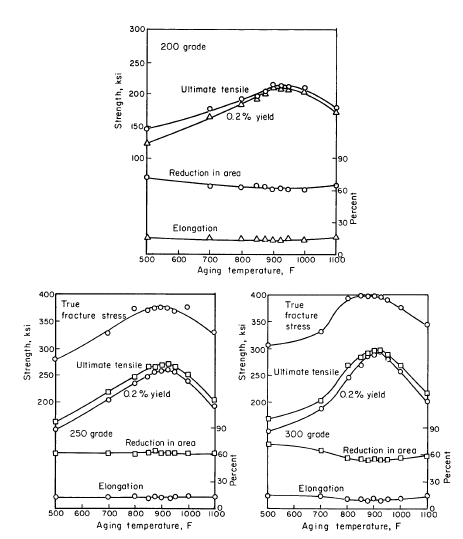
Figure 4. The effect of aging temperature on the strength values of 200-250 and 300 grade maraging steel after solution for 30 minutes at 1500 oF. Aging process is 3 hours.
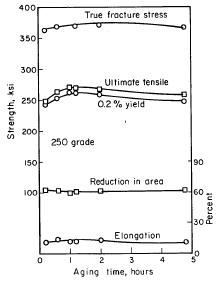
Figure 5. The effect of aging time on the aging process performed at 900 oF after annealing of 250 grade maraging steel for 30 minutes at 1500 oF.
Applications
Maraging steel has found a lot of use in tool materials. Its mechanical properties such as tensile strength and very high yield strength cause it to be used here. In addition to these features, impact resistance, fatigue strength, compression strength, toughness, ductility, hardness and wear resistance are among the features to be considered. It has the feature to be processed and to provide cold and hot forming convenience. It has a good resistance to high crack propagation and can be welded and polished. Extremely low furnace temperatures are required for heat treatment. Uniform structure is obtained during heat treatment and the size change is quite low. Due to the fact that the carburization or decarburization layer does not form on the surface, minimum distortion occurs in hardening. It maintains its strength up to 350 oC. Since it has a low carbon martensitic structure, it is soft and workable. The surface can be hardened by nitration. General application areas of maraging steel are rocket production and rocket engine body, air tunnel model, gun recoil springs, AC motors, aircraft landing gear, high performance shafts and bolts, extrusion dies, casting dies, crankshaft working at medium temperatures, under load and in impact environment the automatic gun firing pin which makes rapid transition from hot to cold.
Table 5. Application Areas of Maraging Steel
|
Aviation
|
Die Tools
|
Structural Engineering and Ammunition
|
|
Aviation parts (such as landing gear, wing connections)
In solid fuel rocket body
Jet engines in the start rotor
Airplane stop on the hook rope
In torque transmission shaft
In the ejektor release unit
|
In cold forging, as panches and as a die cushion
In extrusion presses in ram and mandrel.
In aluminum casting and extrusion dies
In cold production calibration mandrels in pipe production
In casting molds of zinc based alloys
Machine components
Gear
Screw
Plaque
|
Lightweight portable military bridges
In fasteners
|
Use in Mold Tool Applications
The main reasons for its use in tool applications are high strength, easy heat treatment, dimensional stability, no decarburization in heat treatment, good machinability and high hardness. It has very good resistance to thermal crack formation and erosion caused by molten aluminum.
It has been developed as die casting operation kits as the main use. It has found use in die casting pins, core and die cast aluminum. The temperature on the mold surface reaches between 1000 oF and 1100 oF. For this reason, maintaining hardness and strength at these high temperatures is a very important factor for ensuring resistance to thermal cracking. Tests have shown that the hardness of the die-block material 250-grade and 300-grade maraging steel exposed to a temperature of 1200 oF for 200 hours remains at 34-25 Rockwell C. Performance tests show that it sometimes provides 25 times longer life than other steels. It meets its high cost in terms of longevity.
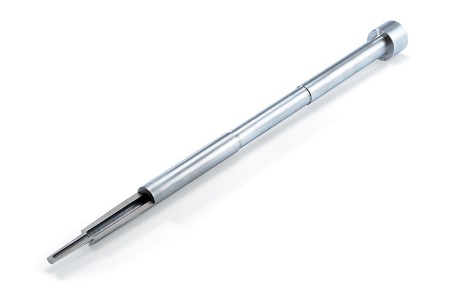 |
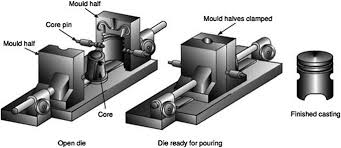 |
|
Figure 10. (a) Core Pin, (b) Casting Mould Diagram
|
Figure 11 shows examples of tools used in die casting. The mold shown in Figure 11 (c) is made of VAR 300 grade 18% maraging steel. The reason for choosing this material is that the required finishing dimensions in the mold are easily obtained in this material. The stress that occurs in processing can be removed with very low dimensional changes during heat treatment.
Figure 11. (a) Aluminum die casting core produced from 300 grade VAR maraging steel, (b) Aluminum die casting core pin made from 250 grade VAR maraging steel, (c) Aluminum die casting mold made of 300 grade VAR maraging steel, 5x5x2 inches.
Figure 12 shows the pressurized plastic transfer mold block made of VAR 250- grade material. In order for the mold having a very complex size and structure to withstand the pressure, the final surface dimensions must be very good during the heat treatment in order to provide strength and hardness properties. After 900 oF and 4 hours aging, 50 Rockwell C hardness was obtained and distortion in all dimensions was measured as 0.0008 inc. Without cracking. There is no other suitable steel for this type of process.
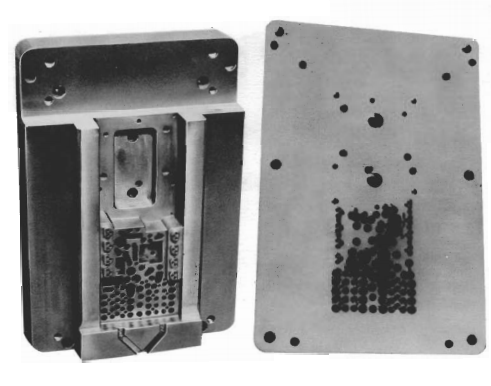
Figure 12. Plastic transfer mold block made of 250 grade VAR maraging steel. Mold dimensions 8 x 3 3/8 x 12 inches.250 grade VAR maraging çeliğinden üretilmiş plastik transfer kalıp bloğu. Kalıp ölçüleri 8 x 3 3/8 x 12 inches.
Maraging steels are used especially in extrusion tools in molds, mandrels and rams. Zirconium, beryllium, high nickel alloy and similar materials are produced with high extrusion pressures, since they are highly stiff in the extrusion method in forming wire, rod, pipe and other forms. The high yield strength of 300 grade VAR maraging steel allows it to be used as the ideal ram material for these extrusion operations. Tool steels show breakage under 180-210 ksi load. However, this problem can be increased to 230 ksi or above in ram produced from 300 grade VAR steel. Figure 13 (b) shows the aluminum extrusion die. During heat treatment, hardness, resistance to extrusion temperature and dimensional stability allow VAR 18% nickel 250 grade maraging steel to be used for this application. Maraging steel mandrels are also used for extrusion of brass and copper alloys.
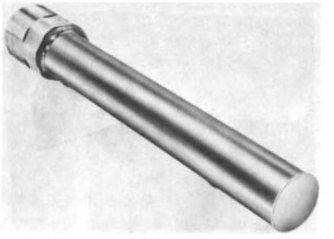 |
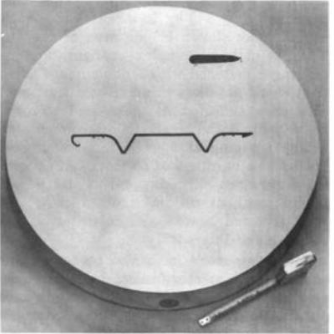 |
|
Figure 13. 300 Grade VAR Extruded RAM, (b) 300 grade VAR Aluminum extrusion die.
|
Use in Structural Application
Figure 14 shows load cell made of 300 grade VAR maraging steel with 270 ksi yield strength.
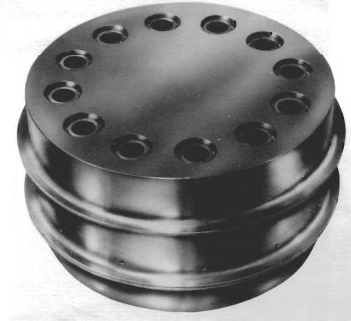
Figure 14. 300 grade VAR maraging steel load cell, resisting 5 million pounds of strength.
In applications where bending strength is critical, maraging steel is used. Figure 16 shows the shaft used in the helicopter main propeller made of 250 grade VAR steel. The lack of heat treatment and weldability are important factors in use for this application. Using maraging steel here reduced the weight of the unit and reduced production costs.5 milyon pound güce dayanan 300 grade VAR maraging çeliği yük hücresi.
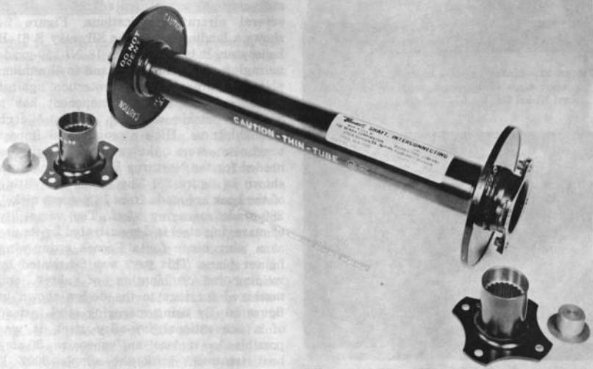
Figure 15. Shaft made of VAR 250 grade maraging steel
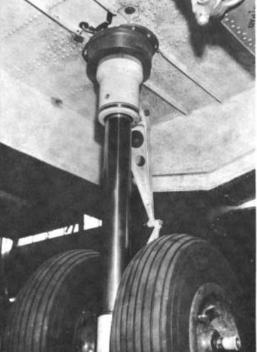 |
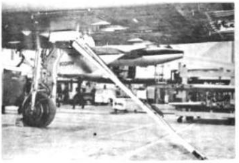 |
|
Figure 16. (a) Sikorsky S6 –R aircraft landing gears made of maraging steel, (b) Northrop F-5 tactical aircraft's holding hook made of maraging.
|
Strength and impact strength provided advantages in some aviation applications of maraging steel. Figure 16 (a) shows the landing gear of the Sikorsky S6 –R helicopter. Made of 18% Ni 250 grade maraging steel. Nickel and chrome plating increased corrosion resistance. Tubing components have a 3 ½ inch outer diameter and a 3/8 inch wall thickness. In addition, the Northrop F-5 stop apparatus (hook) is shown in figure 16 (b). Since high strength and impact resistance are important in this apparatus, 250 grade steel material is used.
References
[1] Nickel Development Institude, “18 Per Cent Nickel Maraging Steel”, Publication No. 4419, 1976.
[2] Aline Castilho Rodrigues, Heide Heloise Bernardi, Jorge Otubo, “Microstructural Analysis of Co-Free Maraging Steel Aged”, J. Aerosp. Technol. Manag., São José dos Campos, Vol.6, No 4, pp.389-394, Oct.-Dec., 2014.
[3] A.M. Hall, C.J.Slunder, “The Metallurgy, Behavior, and Application of the 18-Percent Nickel Maraging Steels”, NASA SP-5051, 1968.
[4] Rayan Bhar, Julien Jourdan, Vincent Descotes, and Alain Jardy, “An experimental study of the inclusion behavior during maraging steel processing”, 2019.
[5] ASM Hand Book, Vol. 4; p. 529.
[6] Decker, R. F., Eash, J. T., and Goldman, A. J., “Eighteen Percent Nickel Maragin Steel,” Trans. ASM, 55,58-76 (1962).
[7] Decker, R. F., Novak, C. J., and Landig, T. W., “Developments and Projected Trends in Maraging Steels,” Jnl. Metals, 19 (11), 60-66 (1967).
[8] Sadowski, E. P., “12% Ni Maraging Steel,” Metals Eng. Quart, 5,56-64(1965)